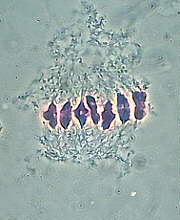
Up until the second half of the 19th century, microscopers were mainly occupied with the shape of cells and tissues. In 1840, R. BROWN discovered cell nuclei in the epidermal cells of orchids and the anthers of Tradescantia. M. SCHLEIDEN and suggested that they were important for cell division, but could find no proof for his assumption. Only few cell components like chloroplasts could be seen without further effort. Every participant of a basic botanical course will find out that the nucleus is easily identified with some specimen (for example the epidermal cells of onion), while it remains invisible in others. C.v.NÄGELI proved its existence in cells of algae, fungi, bryophytes and vascular plants in patient studies.
Two developments were decisive for the analysis of intracellular structures. One was the optimizing of microscopic lenses , the other the use of specific dyes. With the rise of organic chemistry and that of the colour industry, a range of synthetic dyes became available. Many of them were suiteable for microscopy. With their help, it was possible to stain specific cell components selectively. In 1849, HARTUNG developed the carminic acidic procedure, in 1863 WALDEYER the haematoxiline colouring. This paved the way for the detailed study of the processes of cell and nuclear division (cytokinesis and karyokinesis) and the elucidation of the process of pollination.
As has been mentioned before , M. MALPIGHI was trying to find similarities between animal and plant bodies. His idea based on assumptions that go back as far as antiquity. The development of the microscope and of exact histological studies particularly during the first half of the 19th century refuted his concept. The situation at the cellular level was completely different. As soon as 1838/39, the cell theory formulated by M. SCHLEIDEN and T. SCHWANN had pointed out the similarities between plant and animal cells. The propagation by division and the existence of a nucleus were further proofs.
In 1877, the German anatomist O. HERWIG demonstrated that the
process of fertilization is based
upon the penetration of the egg cell by the sperm's head and that
both sperm and egg cell contain cell nuclei, which fuse in the
fertilized egg. His experimental animal was the urchin. The
importance of pollen for the pollination of plant egg cells was first
noticed by CAMERARIUS. J.
G. KÖLREUTER still thought that the pollen would secrete an
oily, pollinating substance. G. AMICI (1786-1863) from Italy
discovered the development of the pollen tube and its penetration of
the micropyle in 1830.
The question of the contact between the tip of the pollen tube and the nucleus of the egg cell remained unanswered until E. STRASBURGER proved that the pollen tube does not stay intact, but that its tip disintegrates upon contact with the embryo sac and that one of its nuclei fuses with the nucleus of the egg. He inferred that the characters of the father are transferred by the nucleus of the pollen and that it generally are the nuclei, that determine the specific development of the new organism. The fusion product is the zygote. In the first edition of his textbook on botany E. STRASBURGER writes:
" All cell nuclei of an organism are descendants of the germ cells' nuclei (egg or pollen), which themselves stem from the nuclei of earlier generations. A new formation of nuclei does take place nowhere. In the same way all cytoplasm of an organism is derived from the cytoplasm of the germ cells."
|
|